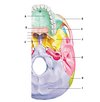Head and Neck 1 Flashcards
What is the most common type of joint between the bones of the skull?
Suture joint (fibrous)
What are the 3 parts that the skull can be divided into?
Neuro-cranium
Facial skull (viscera-cranium)
Mandible
What part of the skull is A?

Neuro-cranium
What part of the skull is B?

Facial skull (viscera-cranium)
What part of the skull is C?

Mandible
What is A?

Compact bone
What is B?

Spongy bone
What are the 3 layers of the skull bone?
Compact bone, spongy bone, compact bone

Which part of the skull bone houses red marrow?
Spongy bone
What is A?

Parietal bone
What is B?

Sagittal suture
What is C?

Coronal suture
What is D?

Frontal bone
What is E?

Nasal bone
What is F?

Sphenoid bone
What is G?

Temporal bone
What is H?

Occipital bone
What is I?

Lambdoid suture
What does the sagittal suture connect?
Left and right parietal bone
What does the coronal suture connect?
Left/right parietal and frontal bone
What does the lambdoid suture connect?
Left/right parietal and occipital bone
What kind of bones are bones of the facial skeleton?
Irregular
What do the facial bones give attachment to?
Muscles of the tongue, mastication and pharynx
What is A?

Frontal bone







































































